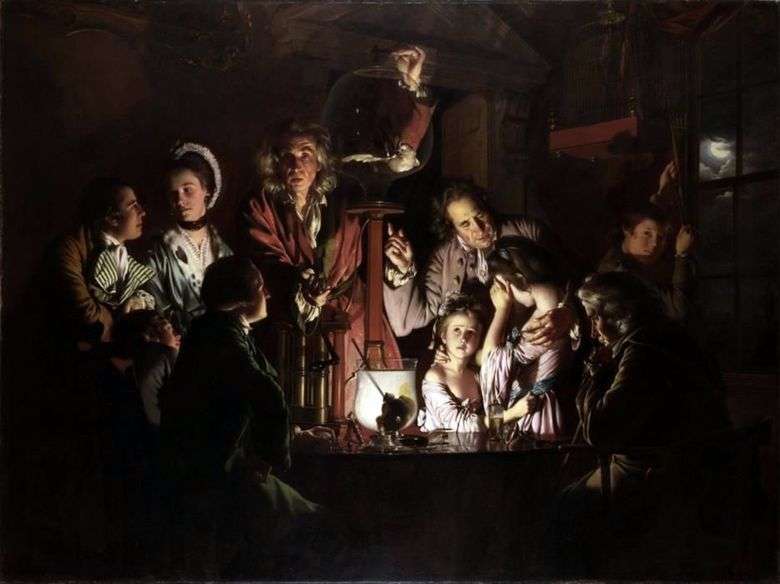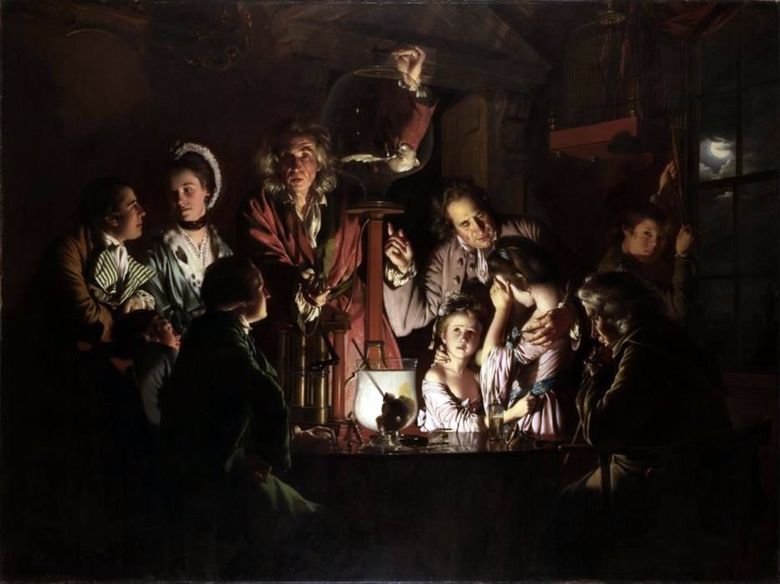
This canvas bears the imprint of a genius and has no analogues in the portrait genre. The action of the picture takes place at night in a darkened room, in which a group of friends and like-minded people come together to see a demonstration of a new device, an air pump, whose functional features are shown with the help of a bird choking in vacuum.
Wright combines the high drama of the scene with prosaic reality and makes the viewer feel like a witness to the experiment, carefully transferring his natural observations to the canvas. The absence of a central character serves the same purpose.
The presence of candles and the general atmosphere of the painting testifies to the influences of Caravaggio, Rembrandt, Gerard Dow and other, less well-known artists.
As models, Joseph Wright used his friends and neighbors, meticulously creating the archetypes of age, gender, and understanding of the situation. For example, the young couple on the left is too passionate about each other to take care of the tragic experiment that makes it impossible for the bird to breathe, while the young girls on the right mourn the fate of the cockatoo. Their father tries to console them, explaining that not all the air will be removed, and the bird will survive. More to the right, a gentleman with glasses in his hands, thought about the life, death and place of a person in this system. Wright from Derby demonstrates his opinion about the place of women and men in society and the paradigm of their behavior. Men rely on thoughts with logic, while women tend to perceive everything emotionally.
It is worth noting the realism of the depicted equipment. The pump, which is the main device in this story, corresponds to the real prototypes of that time. In addition, one can see a candle, a stopper and the Magdeburg hemispheres, which serve to demonstrate the pressure exerted by the vacuum, which echoes the functions of the pump.
It is believed that the glass ball and the human skull in this picture are a reminder of death, the motif commonly used in the works of Vanitas, highlighting the passing nature of earthly pleasures and the transience of life.
 Bird’s enemies by Alexey Korzukhin
Bird’s enemies by Alexey Korzukhin Experimenta con un pájaro en una bomba de aire – Joseph Wright
Experimenta con un pájaro en una bomba de aire – Joseph Wright Une expérience avec un oiseau dans une pompe à air – Joseph Wright
Une expérience avec un oiseau dans une pompe à air – Joseph Wright Gamayun, a prophetic bird by Victor Vasnetsov
Gamayun, a prophetic bird by Victor Vasnetsov Hope II by Gustav Klimt
Hope II by Gustav Klimt Girl with a bird by Ivan Vishnyakov
Girl with a bird by Ivan Vishnyakov Great experiment by Ilya Glazunov
Great experiment by Ilya Glazunov Bird in a cage by Nicola Lancre
Bird in a cage by Nicola Lancre